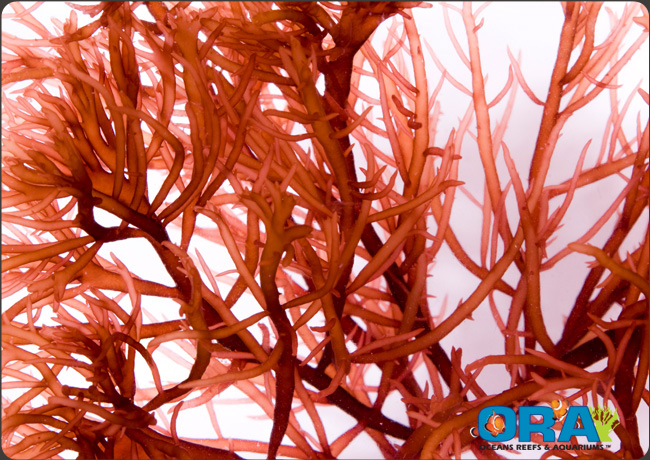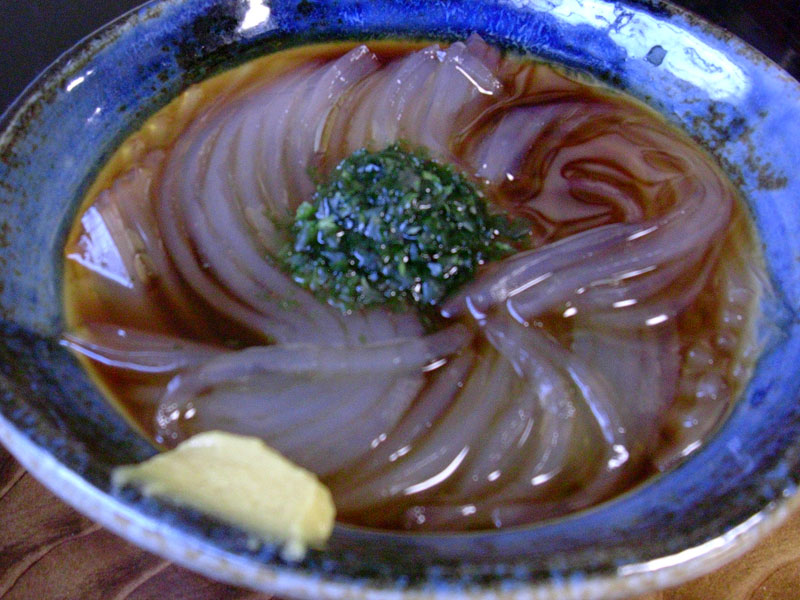 It seems I owe everyone a brief history of one of my favorite ingredients: Agar agar. It was invented in Japan where it is known as Kanten. Agar agar is the Malaysian word for the algae it derives from. (pictured left)
It seems I owe everyone a brief history of one of my favorite ingredients: Agar agar. It was invented in Japan where it is known as Kanten. Agar agar is the Malaysian word for the algae it derives from. (pictured left)  Beginning around 700 AD, there was a popular dish in Japan called tokoroten. This dish is made by boiling various seaweeds in water to create a seaweed flavored broth. The broth is then allowed to chill until it forms a firm jelly.
Beginning around 700 AD, there was a popular dish in Japan called tokoroten. This dish is made by boiling various seaweeds in water to create a seaweed flavored broth. The broth is then allowed to chill until it forms a firm jelly. | |
| various seaweeds |
This jelly is then pushed through a box with a grate, dividing the jelly into noodles. This is served cold, dressed with soy sauce, scallions, toasted nori, miso paste, etc.
 |
| Tokoroten |
 The traditional process for the creation of Agar agar begins with seaweed, primarily those classified as red algae. The seaweed is boiled and strained. The resultant jelly is cut into blocks which are then forced through a cutter to create noodles. The noodles are laid out on bamboo mats at the appropriate altitude, usually facing the sun. Shaved ice is sprinkled over the noodles and they are allowed to freeze dry naturally for several days until they are dry and devoid of color and flavor. This is how the thread agar that I prefer to use and which can be found affordably at most Asian markets is made. One can see what a natural process this is. Many people think of Agar agar as a "Molecular Gastronomy" ingredient. Like many other ingredients incorrectly labeled this way, it is not a chemical, but a natural substance used traditionally for many years.
The traditional process for the creation of Agar agar begins with seaweed, primarily those classified as red algae. The seaweed is boiled and strained. The resultant jelly is cut into blocks which are then forced through a cutter to create noodles. The noodles are laid out on bamboo mats at the appropriate altitude, usually facing the sun. Shaved ice is sprinkled over the noodles and they are allowed to freeze dry naturally for several days until they are dry and devoid of color and flavor. This is how the thread agar that I prefer to use and which can be found affordably at most Asian markets is made. One can see what a natural process this is. Many people think of Agar agar as a "Molecular Gastronomy" ingredient. Like many other ingredients incorrectly labeled this way, it is not a chemical, but a natural substance used traditionally for many years. In honor of Agar agar's humble roots as a noodle, I have selected a recipe for Milk Chocolate Pudding Noodles.
In honor of Agar agar's humble roots as a noodle, I have selected a recipe for Milk Chocolate Pudding Noodles.Ingredients:
10 grams Agar agar, soaked in water for at least an hour and sqeezed dry
300 grams Milk
250 grams Milk Chocolate.

- First, add the milk to the agar in a pot and bring to a boil.
- Whisk thoroughly, it will be difficult to keep the milk from boiling over, this is normal. If necessary, reduce the heat slightly.
- When the agar has fully melted (about 2-3 minutes) strain through a mesh strainer.
- There may be some small bits of Agar left behind. This is normal. It is very difficult at this concentration and in a liquid other than water to melt the Agar much more thoroughly.
(This is one of the reasons I prefer the thread Agar. Powdered agar, undissolved at this stage, would leak through the strainer and leave behind a grainy product.)
- Add the milk chocolate. Whisk until fully incorporated.
 - Meanwhile, take a very flat cookie tray, or other shallow vessel and line with plastic wrap.
- Meanwhile, take a very flat cookie tray, or other shallow vessel and line with plastic wrap.
- Pour chocolate mixture into lined pan. Refrigerate until set (about 1-2 hours or up to overnight) Be sure to keep level.

- When Noodle has cooled, gently transfer to a flat surface by lifting up on plastic wrap.

- If the mixture does not seem ready to pull away from plastic like this, allow to set in the refrigerator longer. Do not fully wrap in plastic as some drying is necessary for agar to set correctly.
- Trim the edges and carefully cut off a nice even slice.

- Allow this noodle-like slice to drape gently over the plate and its components. Pictured are some raspberry slices and violas. The texture is like pudding, but the look is what makes it sick!

Additionally, this recipe can work with almost any fat-based ingredient: peanut butter, other nut pastes, marzipan, even cheese, especially goat cheese or marzipan. Some play with the ratio may be necessary (a little less milk, a little more agar, etc) but it should be pretty close. High fat is necessary, because the fat crystals keep the starch granules small, preventing the jelly from getting too brittle.
Cool beans.





I love working with agar..but I didn't know the history behind it, good info chef..
ReplyDeleteI also love the chocolate noodle plate with edible flowers... nice touch!!!!!
I always wondered about how to use agar with my molecular gastronomy kit I bought. Can I also do this with the powder?
ReplyDeleteBy the way, Chef Shelton sir, your description on each instruction is easy to understand and detailed. I love it and can't wait to try it this weekend.
Will let you know how it went :D
Thank you very much!
DeleteYea, you can totally use powder and achieve the same results. However, the given measure for thread Agar is much higher because it is partially soaked with water. A dry measure for the same application would only be around 3 grams, roughly 1/4 teaspoon. (yet another reason I don't like the powdered stuff, much harder to measure ;-))